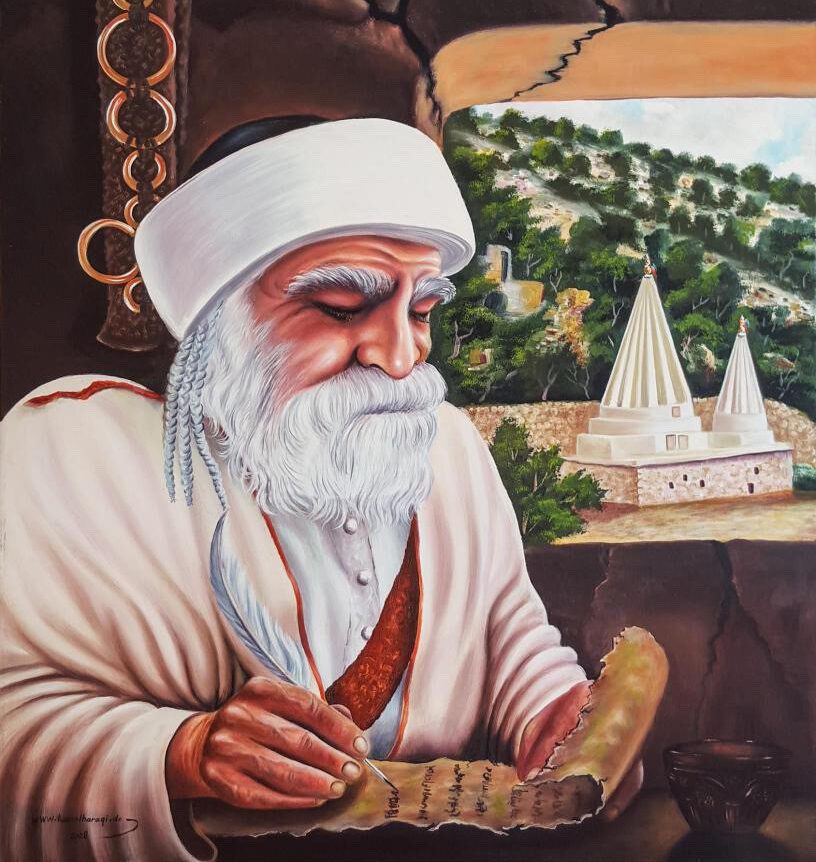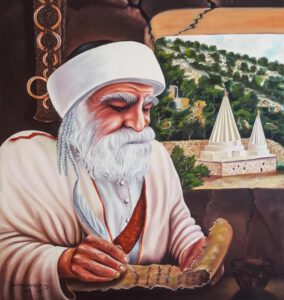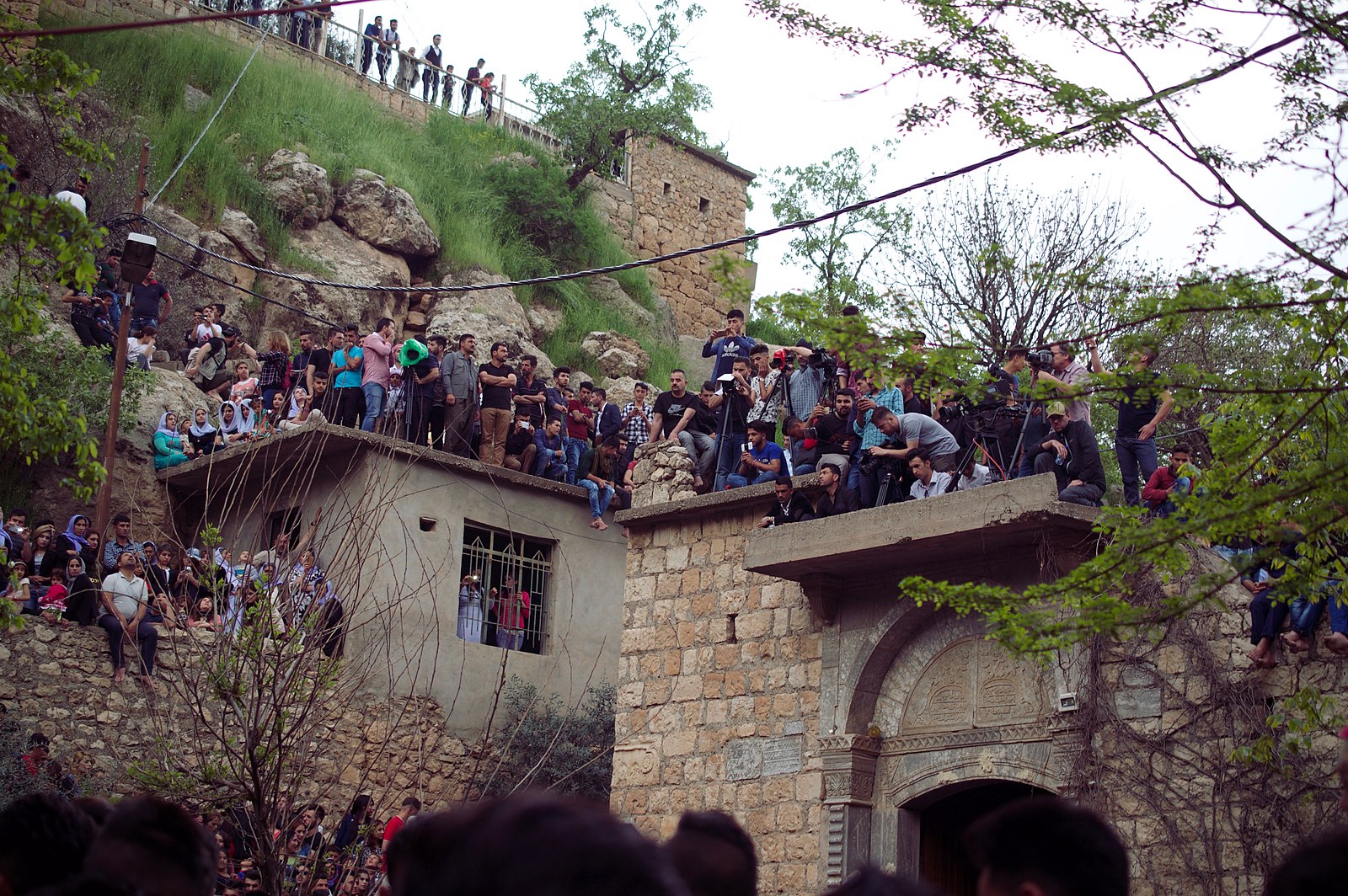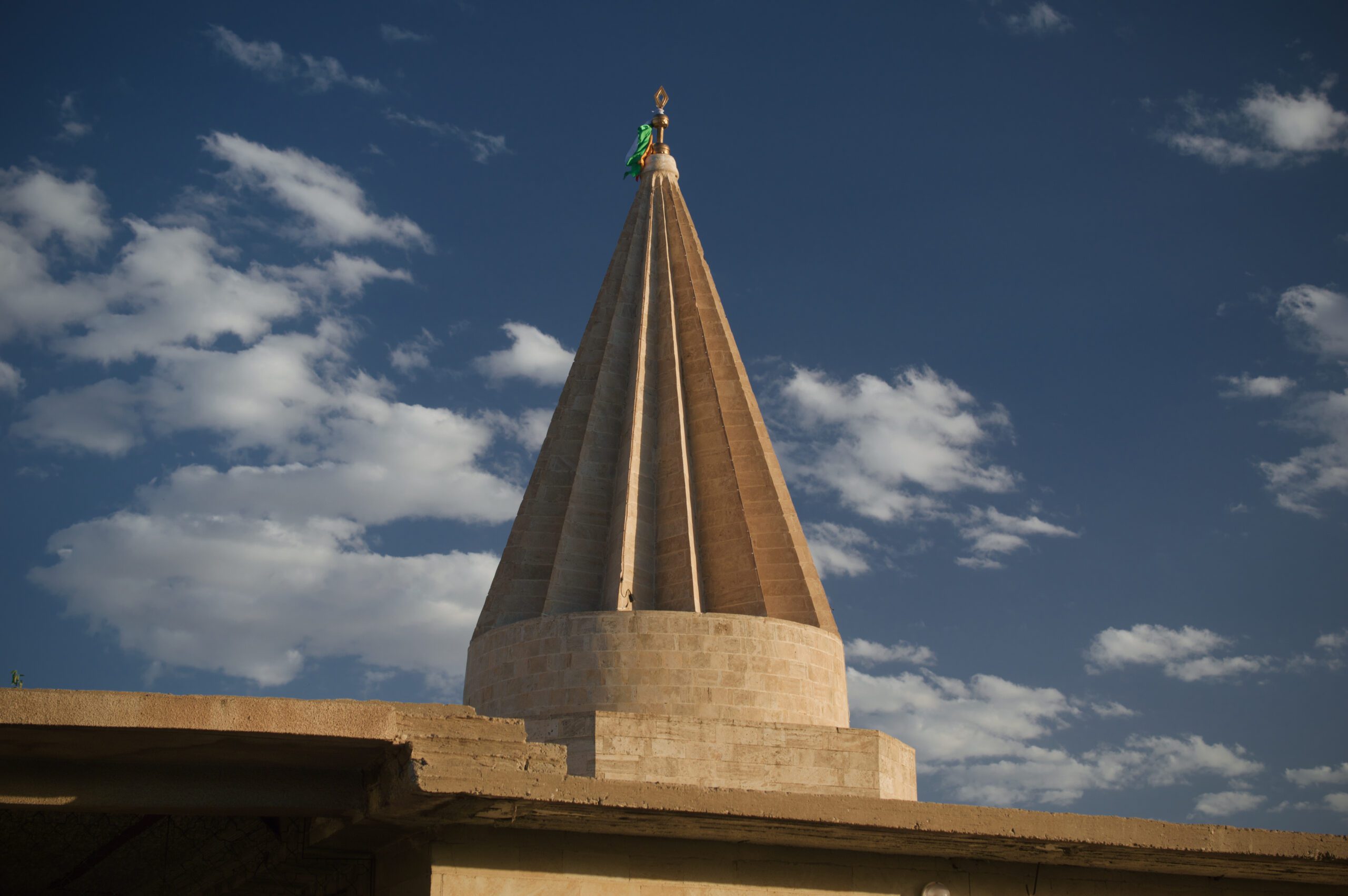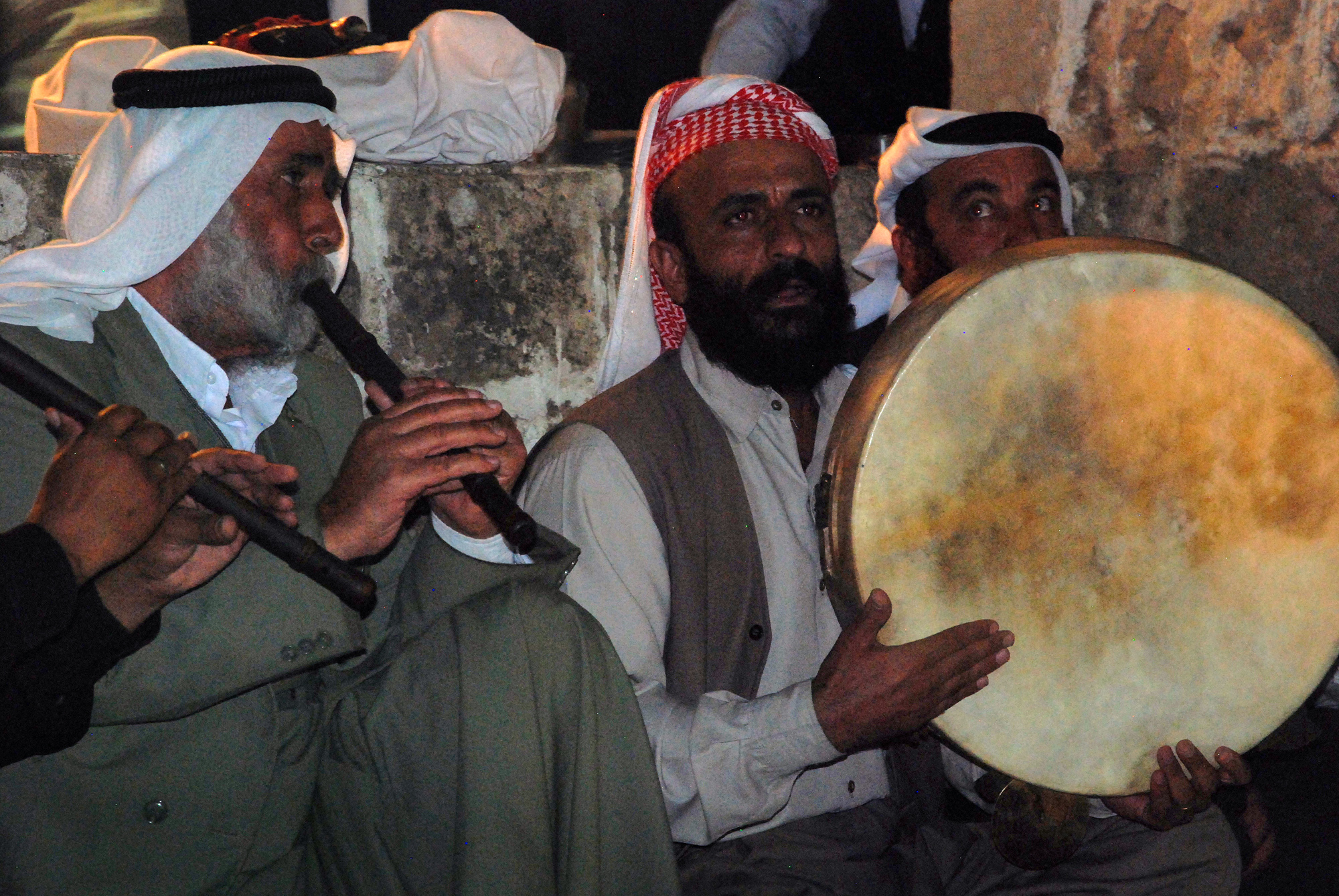Qewlê Kofa
Qewlê Kofa or Qewlê Kofiya (Qewl of the Headdress), also known as Qewlê Pîrê Libnana (Qewl of Pîr Libnan), or after its first line, Qewlê Dilê Min î bi Kovan e (Qewl of ‘My Heart is Filled with Sorrow), is a Qewl believed to have been composed by Dawidî bin Derman. It praises the powers of Pîrê Libnan, an Ezidi holy figure who is considered the Xudan (lord, patron, protector, master) of weddings and family life. According to Ezidi tradition, he built many places of pilgrimage and thus his name translates to “the Pîr of building-blocks.” However, in a Serhatî about Xidir Îlyas told by the Qewlbêj and Koçek Mam Adil Şêxkî, it is mentioned that Pîrê Libnan lived around the time of Alexander the Great (Eskender Makidonî) and was gifted by Şêşims with his “maş” (lit. ‘wage’ but may refer to a saint’s special power in Ezidism). This “maş” consisted of two building-blocks (‘libn’) that gave him the ability to predestine a man and a woman into marrying each other. As a way to prove his power, he predestined the son of the west’s ruler and daughter of the east’s ruler to marry each other and Alexander the Great was born from this marriage. During the feast of Xidir Îlyas/Nebî in February, he as well as Xidir Nebî is invoked by Ezidis who are seeking luck and want to inquire about their love life, wedding and happiness.[1]Omarkhali, Khanna. (2017). “The Yezidi Religious Textual Tradition: From Oral to Written Categories, Transmission, Scripturalisation and Canonisation of the Yezidi Oral Religious Texts.” … Continue reading[2]قةول و بةيتن ئيزديان. (2024, February 23). كوجاك عادل شيخكي بحس ل خدر الياس و اسكندار كةت [Video]. YouTube. … Continue reading
Qewlê Kofa tends to be recited together with Beyta Cindî, Qewlê Babekrê Omera, as well as during Sema’ya Şêxê Hesen (“Sema’ of Sheikh Hesen”) ceremony together with Qewlê Şêxê Hesenî Siltan e. It has two variants with different melodies (‘kubrî’) depending on under which context it is being recited. During the Sema’ya Şêxê Hesen ceremony and when it is performed together with Qewlê Babekrê Omera, it is performed with a heavy (‘giran’) kubrî, but with Beyta Cindî, it gets performed in a “quick” (‘bi lez’) kubrî. Both variants below were recorded and translated by the researcher Khanna Omarkhali from the recitation of Merwanê Xelîl, a famed Ezidi religious expert and Qewlbêj of the Mirîd caste from the village of Babîra in Shekhan region.[3]de la Bretèque, Estelle Amy; Omarkhali, Khanna (26 September 2022). “The Yezidi Religious Music“
Variant A: quick kubrî
Stanza 1
1. Dilê minî bi kovan e,
My heart is filled with sorrow,
2. Pîrê bi nav Libnan e,
The eminent Pîr is Libnan,[4]In the source, this line is translated as “The Pîr is named Libnan”, however, in Kurdish, the phrase “bi nav” can be used to describe someone who has made a name for himself. … Continue reading
3. Pîrê Libnano, giyano zeynê bi sura Şêxalê Şemsa ne.
O Pîr Libnan, dear one, adornment of the Mystery of Sheikh Alê Shemsa.
Stanza 2
1. Kofiya te ye bi qewî ye,
Your headdress (kofî) is powerful,[5]In the source, qewî is translated as “strong”, here we replaced it with the synonym “powerful” as it suits the context better.
2. Lê cema bûn ewliya,
The saints (ewliya) gathered around it,
3. Pîrê Libnano giyano berê zeynê bi sura Şêxê Adî ye.
O Pîr Libnan, dear one, adornment of the Mystery of Sheikh Adi.
Stanza 3
1. Kofiya te ye cî da,
Your headdress (kofî) is in its place,
2. Lê cema dibûn mirîde,
The Mirîds were gathering around it,
3. Pîrê Libnano giyano zeynê bi sura Siltan Êzîd e.
O Pîr Libnan, dear one, adornment of the Mystery of Sultan Ezid.
4. Ay Pîrê ez bim xulamo.
O Pîr, let me be your servant.[6]In the source, xulam had been translated to “slave,” however, in Kurdish it is understood more as “servant,” which is more appropriate in this context.
Stanza 4
1. Kofiya te ye mezin e,
Your headdress is great,
2. Lê cema bûn momine,
The believers gathered around it,
3. Pîrê Libnano, giyano zeynê bi sura Melik Şêxisine.
O Pîr Libnan, dear one, adornment of the Mystery of the angel Şêxisin.
Stanza 5
1. Kofiya te ye bû kêr,
Your headdress is pure,
2. Wa dinya bûye dukir,
It has become memorable in the world,[7]In the source, this line was translated as “It appeared in the world,” but clearly the term dukir is borrowed from Arabic ذِكْر (ḏikr, “recollection, remembrance”).
3. Pîrê Libnano, giyano zeynê bi sura Şêxûbekir.
O Pîr Libnan, dear one, adornment of the Mystery of Şêxûbekir.
Variant B: heavy kubrî
Stanza 1
1. Dilê minî bi kovan e,
My heart is filled with sorrow,
2. Pîrê bi nav Libnan e,
The eminent Pîr is Libnan,
3. Pîrê Libnano, giyano zeynê bi sura Şêxalê Şemsa ne.
O Pîr Libnan, dear one, adornment of the Mystery of Sheikh Alê Shemsa.
4. Ay Pîrê ez bim xulamo.
O Pîr, let me be your servant.
Stanza 2
1. Kofiya te ye bi qewî ye,
Your headdress (kofî) is powerful,
2. Lê cema bûn ewliya,
The saints (ewliya) gathered around it,
3. Pîrê Libnano giyano berê zeynê bi sura Şêxê Adî ye.
O Pîr Libnan, dear one, adornment of the Mystery of Sheikh Adi.
4. Ay Pîrê ez bim xulamo.
O Pîr, let me be your servant.
Stanza 3
1. Kofiya te ye cî da,
Your headdress (kofî) is in its place,
2. Lê cema dibûn mirîde
The Mirîds were gathering around it,
3. Pîrê Libnano giyano zeynê bi sura Siltan Êzîd e.
O Pîr Libnan, dear one, adornment of the Mystery of Sultan Ezid.
4. Ay Pîrê ez bim xulamo.
O Pîr, let me be your servant.
References[+]
| ↑1 | Omarkhali, Khanna. (2017). “The Yezidi Religious Textual Tradition: From Oral to Written Categories, Transmission, Scripturalisation and Canonisation of the Yezidi Oral Religious Texts.” pp. 350, 434, 534, 541 |
|---|---|
| ↑2 | قةول و بةيتن ئيزديان. (2024, February 23). كوجاك عادل شيخكي بحس ل خدر الياس و اسكندار كةت [Video]. YouTube. https://www.youtube.com/watch?v=tAFN7ocY8CM (Accessed 24 June 2023) |
| ↑3 | de la Bretèque, Estelle Amy; Omarkhali, Khanna (26 September 2022). “The Yezidi Religious Music“ |
| ↑4 | In the source, this line is translated as “The Pîr is named Libnan”, however, in Kurdish, the phrase “bi nav” can be used to describe someone who has made a name for himself. This is related to the word “navdar” (well-known) or the phrase “bi nav û deng” (renowned, famous). |
| ↑5 | In the source, qewî is translated as “strong”, here we replaced it with the synonym “powerful” as it suits the context better. |
| ↑6 | In the source, xulam had been translated to “slave,” however, in Kurdish it is understood more as “servant,” which is more appropriate in this context. |
| ↑7 | In the source, this line was translated as “It appeared in the world,” but clearly the term dukir is borrowed from Arabic ذِكْر (ḏikr, “recollection, remembrance”). |
